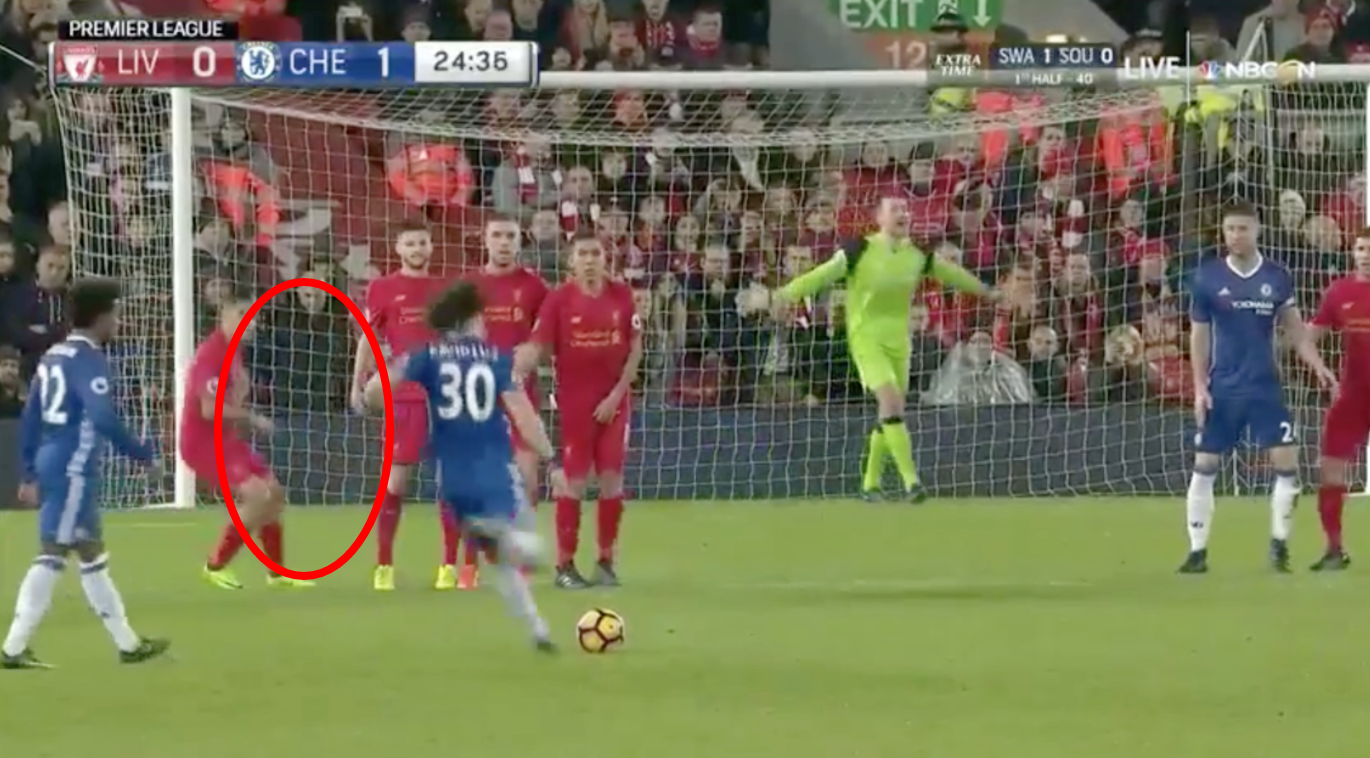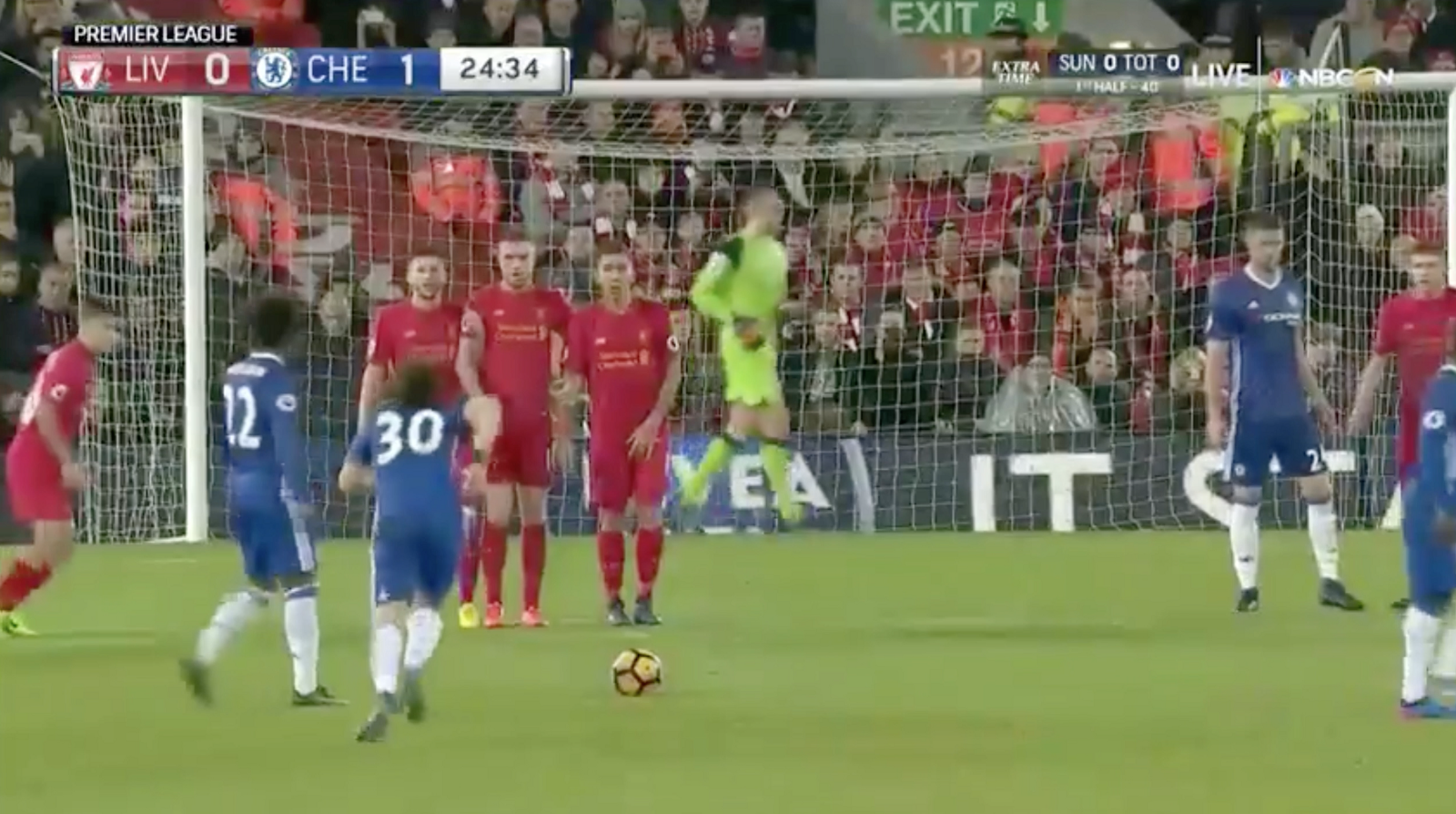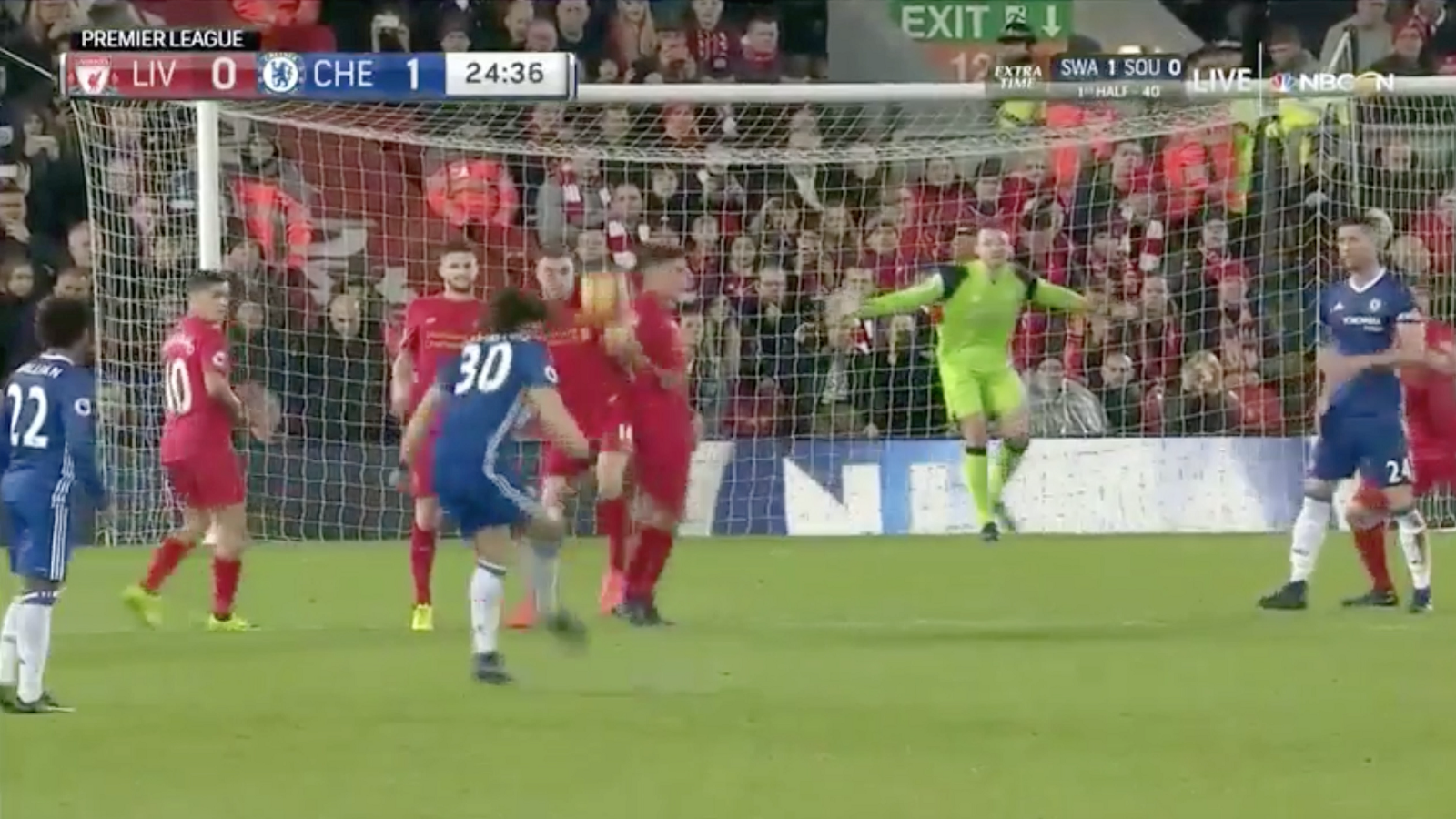Breaking down the problems that led to Chelsea’s opening goal against Liverpool

In the 25th minute of 1–1 draw between Chelsea and Liverpool on Tuesday night, we saw a scorcher of a free kick goal from Chelsea’s David Luiz to give his team the 1–0 lead. However, as I was watching this play out in real time, I was scratching my head as to what Liverpool’s goalkeeper, Simon Mignolet, was doing on the goal.
As David Luiz struck the ball, Mignolet was caught in the middle of the goal, arms flailing, and shouting at his back line oblivious that the play had started. To me this seemed to be a strange and awkward time to be organizing your defense. It should have been time for him to get set and in a position to attempt to make the save on the resulting free kick. I want to break it down for you below and help you understand how it went so wrong for Simon Mignolet and the rest of the Liverpool defense.
When the referee blew the whistle to signal a foul 25–30 yards from goal, Mignolet and the rest of his Liverpool teammates knew a direct free kick was coming. The absolute first thing you do as a goalkeeper in regards to direct free kicks is “ask the referee for the whistle.” This means that the play can’t start until the referee blows the whistle. This affords you the time as a goalkeeper and defense to set up your defensive wall as the referee walks out the 10 yards. Until you get that confirmation you must stay put in your goal in anticipation for the shot because the striker of the ball can shoot at any time (a sneaky striker knows this and sometimes won’t ask for 10 yards intentionally to see if he can catch the goalkeeper out of position. Willian has done this before so it’s imperative that Mignolet gets this detail correct, which he does). In this situation, Willian does end up asking for 10 yards. So then, and only then, Mignolet can go to his post to set his wall.
Next, Mignolet must determine how many defenders he wants in his wall. A good rule of thumb to follow in regards to setting your wall is anywhere inside and around the “D” within 25–30 yards (or the defensive arc) you use four or five in the wall. (I don’t ever like using more than five because that is when I start to lose sight of the ball. You must always be able to see the ball when setting your wall. If you can’t see the ball being struck you lose precious milliseconds on your reaction time that can make the difference between you saving the ball and giving up a goal.)
This allows the defensive wall to cover one half of the goal for you while you as the goalkeeper cover the other half. Then, every few yards outside the “D,” the ball position allows you to remove one person from the wall. (It must be noted that each goalkeeper has their own preference on exactly how they set this up. This has to do with their size, range, and comfort in dealing with free kicks in addition to who is striking the free kick. Also, you will set your wall differently when facing Messi, Bale, and Payet — because they are so good at free kicks compared to almost everyone else.)

The more confident you are in stopping the shot the less you feel a need to rely on the wall. You keep your information short and sweet here by yelling out your command as follows: “five!” or “four!”
In this situation Mignolet calls for three. I would have chosen four or five (It’s possible he felt confident that three was enough in this situation because there were two right footed players over the ball). This is the first mistake from Mignolet and a little bit naive in my opinion. With two proven free kick takers (Willan and Luiz) over the ball, Mignolet should have been expecting a shot and therefore should have prepared for it by demanding a big and compact wall of at least four players.
Once Mignolet knew how many he wanted in the wall his job was to go over to the near post and make sure the wall was lined up correctly. When setting his wall, he wants his outside defender at the near post to have his inside shoulder in line with the ball and the near post. This allows the wall to cover additional ground outside the frame of the goal in case the striker tries to go around it. This creates a straight line from the ball to the inside shoulder of your defender and ultimately to the post. Any more than that and you aren’t utilizing your wall to its full capacity. If your wall is covering unnecessary ground outside the frame of your goal then it, in turn, won’t be serving its purpose and covering half of the goal effectively. This then leaves you, as a goalkeeper, at a disadvantage because you then have more of the goal to cover yourself, making your job more difficult. When I’m setting my wall I like to have the outside defender turn and face me. This allows us to get eye contact and gives us the possibility to use visual cues if needed to set the wall. Again keep the information short and sweet: “Two right! Hold!” This Mignolet does correctly.

The next mistake from Mignolet comes when he sets Coutinho a yard off the outside of the wall. If there was an attacker on the left wing then I understand wanting him here (but I still would want four in the main part of the wall). However, there’s no one there, which means there is zero reason to have Coutinho where he is. Instead, Coutinho should be part of the main wall because Willian and Luiz are both skilled free kick takers and Mignolet should therefore want his wall big and compact. This wall looks more like swiss cheese.

Once Mignolet’s finished setting his wall, albeit incorrectly, he then must take up a position on his side of the goal where he can see the ball being struck, in addition to comfortably covering his corner and getting set. This is the moment it really starts to fall apart for Mignolet. As he is going back to his side of the goal he switches off and moves his focus from the ball to his marking defenders. You see his hands go in the air as he starts to organize his marking defenders while taking his eyes off the ball.

When you are facing a direct free kick, your sole job is to set your wall (correctly), get in position, get set, and save the incoming shot. If you’re trying to do more than that, you’re trying to do too much and abandoning your sole priority: saving the ball.
Just as he did this, the referee blew his whistle and David Luiz came running in from behind Willian to rip a shot, over the wall, off the post, and into the goal. 1–0 Chelsea.

In this moment, Mignolet forgot the №1 rule of goalkeeping: keep your eye on the ball at all times! If you can’t see it, you won’t save it. A little trickery by Willian and Luiz caught Mignolet off guard on the goal—that’s why the relationships, confidence and trust between the goalkeeper and their defenders is vitally important to the success and efficiency of a team.
However, a goalkeeper has been in and out of the lineup all season, just as Mignolet has been, it can be difficult to build these types of relationships and exude confidence to your peers. This can lead to you getting basic things wrong, like the setting of your wall, in addition to focusing too much on everyone else’s duties, just as it happens here. If Mignolet had set his wall correctly, trusted his defenders, and kept his eyes on the ball he would have at least given himself a chance to save the spectacular shot from Luiz.

